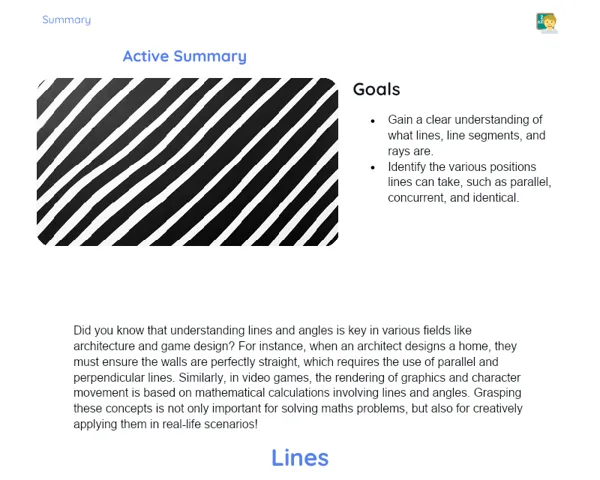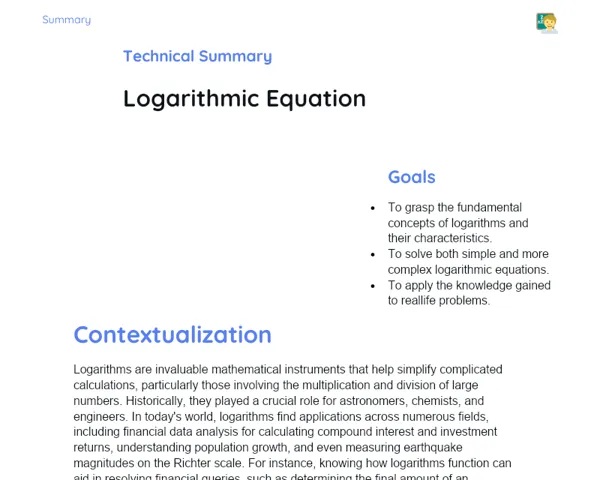Summary Tradisional | Sequences: Terms
Contextualization
A numerical sequence is an organized list of numbers that follows a specific pattern. These patterns can be straightforward, like adding the same number to get to the next term, or more intricate, involving multiplications and other operations. Grasping how to identify and represent these patterns algebraically is vital for solving various math problems and understanding occurrences of growth or change, both in academic settings and everyday situations.
In Mathematics, sequences serve as powerful instruments for depicting and predicting numerical behaviours. For example, in an arithmetic sequence, the difference between consecutive terms remains constant, while in a geometric sequence, each term is derived by multiplying the previous term by a fixed number. These traits make it possible to formulate general equations that can be utilised to determine any term in the sequence, offering a structured and logical approach to tackle problems. Additionally, spotting patterns in numerical sequences can benefit various domains, including science, technology, engineering, and finance.
To Remember!
Definition of Numerical Sequence
A numerical sequence is an ordered list of numbers adhering to a specific rule or pattern. Each number is termed a term and has its own defined position, typically represented by indices like a1, a2, a3, ..., an. Numerical sequences form the cornerstone of mathematics, allowing for organized and structured analysis of numerical data.
Sequences can be classified in various manners based on the rule they adhere to. The most common types are arithmetic and geometric sequences. In an arithmetic sequence, the difference between the terms is constant. Conversely, in a geometric sequence, each term is derived by multiplying the prior term by a constant called the ratio.
A sequence can be represented explicitly, where each term is individually defined, or algebraically, using a general formula that allows for the calculation of any term based on its position. This algebraic representation is crucial for effectively solving complex problems.
-
Numerical sequence: an ordered list of numbers following a specific pattern.
-
Each number is termed a term and has its own position.
-
Common categories: arithmetic and geometric sequences.
Algebraic Representation
The algebraic representation of a numerical sequence is established through a formula that outlines the relationship between the terms and their positions. This formula facilitates the calculation of any term based on its position, aiding in solving mathematical problems. For instance, in an arithmetic sequence, the formula typically is an = a1 + (n-1)d, where a1 denotes the first term, d represents the constant difference, and n indicates the position of the term to be found.
In geometric sequences, the algebraic formula varies. The general formula for a geometric sequence is an = a1 * r^(n-1), where a1 is the first term, r signifies the ratio (the constant used to multiply each term to obtain the next), and n is the position of the term. This formula is invaluable for forecasting the behaviour of terms in a geometric sequence.
The capability to formulate and manipulate algebraic equations is essential for tackling issues involving sequences. It allows learners to identify patterns, make predictions, and recognise equivalent algebraic expressions, which are key skills in mathematics and various practical applications.
-
Algebraic representation: a formula demonstrating the relationship between terms and their positions.
-
Arithmetic sequence formula: an = a1 + (n-1)d.
-
Geometric sequence formula: an = a1 * r^(n-1).
Arithmetic Sequences
An arithmetic sequence is a numerical sequence where the difference between consecutive terms remains constant. This constant difference is referred to as the ratio (d). For example, in the sequence {2, 5, 8, 11, ...}, the ratio is 3 because every term is found by adding 3 to the preceding term. The general formula for determining any term in an arithmetic sequence is an = a1 + (n-1)d, where a1 is the first term and n represents the position of the term.
Arithmetic sequences are ideal for modelling situations where there's a steady increase or decrease. For instance, they can depict the progression of repayments on a loan or the linear growth of a plant over time. With the general formula, it's feasible to forecast any term in the sequence without needing to list all prior terms.
Moreover, arithmetic sequences foster algebraic thought processes, as students learn to identify patterns and formulate algebraic expressions that capture these patterns. This is crucial for problem-solving and understanding more advanced mathematical concepts.
-
Arithmetic sequence: constant difference between consecutive terms.
-
Ratio (d): the constant difference in an arithmetic sequence.
-
General formula: an = a1 + (n-1)d.
Geometric Sequences
A geometric sequence is a numerical sequence in which each term is the product of the previous term multiplied by a constant known as the ratio (r). For example, in the sequence {3, 9, 27, 81, ...}, the ratio is 3, since each term is derived by multiplying the previous term by 3. The general formula for identifying any term in a geometric sequence is an = a1 * r^(n-1), where a1 is the first term and n is the position of the term.
Geometric sequences are critical for modelling situations involving exponential growth or decay, which is prevalent in areas like compound interest in finance, population growth in biology, and wave propagation in physics. The general formula simplifies predicting any term without needing to calculate all preceding terms.
Furthermore, understanding geometric sequences assists students in developing their algebraic skills and comprehending phenomena related to exponential growth. These skills are vital not only in mathematics but also across various other fields, including science, economics, and engineering.
-
Geometric sequence: each term is the product of the previous one multiplied by a constant.
-
Ratio (r): the multiplicative constant in a geometric sequence.
-
General formula: an = a1 * r^(n-1).
Pattern Identification
Recognising patterns in numerical sequences is a fundamental skill that facilitates predicting the next term and understanding the underlying structure of the sequence. Patterns can be uncomplicated, such as constant addition in arithmetic sequences, or more complex, like multiplications in geometric sequences. Spotting these patterns aids in formulating general rules that define the sequence.
For instance, in the Fibonacci sequence {1, 1, 2, 3, 5, 8, ...}, each term is the sum of the two preceding terms. Detecting this pattern allows one to predict that the term following 8 will be 13 (8 + 5). This knowledge finds applications in various fields such as biology, where the Fibonacci sequence represents growth patterns in flora and fauna.
The ability to identify patterns not only streamlines the solving of mathematical problems but also nurtures critical and analytical thinking. Students learn to observe, question, and hypothesise—skills that prove beneficial across all academic disciplines and in everyday life.
-
Pattern identification: the ability to forecast the next term in a sequence.
-
Fibonacci sequence: each term is the sum of the two preceding terms.
-
Application across various fields, like biology and finance.
Key Terms
-
Numerical Sequence: an ordered list of numbers following a specific pattern.
-
Algebraic Representation: a formula describing the relationship between the terms of a sequence and their positions.
-
Arithmetic Sequence: a numerical sequence with a constant difference between consecutive terms.
-
Ratio (Arithmetic): the constant difference between consecutive terms in an arithmetic sequence.
-
Geometric Sequence: a numerical sequence where each term is derived by multiplying the previous term by a constant.
-
Ratio (Geometric): the multiplicative constant in a geometric sequence.
-
Pattern Identification: the ability to forecast the next term in a sequence through observing and analysing patterns.
Important Conclusions
In this lesson, we delved into the notion of numerical sequences and their significance in a range of mathematical and everyday applications. We defined arithmetic and geometric sequences, emphasising their traits and general formulas for figuring out any term within the sequence. We also pointed out the importance of recognising patterns in sequences to make predictions about future terms, illustrated with examples like the Fibonacci sequence.
The algebraic representation of sequences acts as a robust tool that aids in addressing complex problems and grasping concepts linked to growth or change. We discussed the significance of identifying equivalent algebraic expressions and how this aids in simplifying calculations and solving equations.
Mastering numerical sequences not only bolsters mathematical proficiency but also cultivates critical and analytical thinking, which is beneficial across various fields and practical situations. We encourage students to keep exploring these concepts and to apply their learning to new challenges and contexts.
Study Tips
-
Review examples discussed in class and try crafting your own numerical sequences by identifying patterns and writing general formulas.
-
Practice solving problems involving arithmetic and geometric sequences, using algebraic representations to locate specific terms.
-
Investigate the Fibonacci sequence and other notable sequences, examining their applications in diverse fields like biology, finance, and computing.



